Abstract
Oil-in-water emulsions are usually formed during oil production and treatment. Before being discarded, such dispersions should be treated. In order to improve the oil–water separation process using physical processes (decantation, flotation, centrifugation, etc.) the particle size of the disperse phase should be increased. This may be achieved through flocculation, which consists in the agglomeration of various particles or drops, using, as flocculating agents, high molecular weight hydrophilic macromolecules. A few studies have been carried out on the flocculation of finely divided oil drops in brine with the aid of generally ionic polyelectrolytes. This work shows the results obtained using nonionic polymers as flocculants. Commercial samples of poly(ethylene oxide-b-propylene oxide) and poly(vinyl alcohol) were evaluated through flocculation–flotation tests as well as the drop size distribution. The performance of such additives as flocculants for oil–water dispersions is related to their structure, composition, molecular weight and hydrophilic–lipophilic balance. The composition of the produced water is also an important parameter when choosing the features of the flocculant additive.




Similar content being viewed by others
References
Huang JS, Varadaraj R (1996) J Colloid Interface Sci 1:535
CONAMA (1986) Resolução do Conselho Nacional do Meio Ambiente. CONAMA no 20, Brazil
Guida JW, Fruge DE (1995) Hydrocarb Process August 55
Lissant KL (1988) Colloids Surf A 29:1
Woods DR, Diamadopoulos E (1988) Surf Sci Ser 28:369
Saether O, Sjöblom J, Verbich SV, Mishchuk NA, Dukhin SS (1998) Colloids Surf A 142:189
Chanamai R, Herrmann H, McClements DJ (1998) J Colloid Interface Sci 204:268.
Hunter RJ (1991) Foundations of colloid science, vol 1. Oxford University Press, New York
Petsev DN, Denkov ND, Kralchevsky PA (1997) J Dispersion Sci Technol 18:647
Giesbergs M, Kleijin JM, Fleer GJ, Stuart C (1998) Colloids Surf A 142:343
Manoj P, Watson AD, Hibberd DJ, Fillery-Travis AJ, Robins MM (1998) J Colloid Interface Sci 207:294
Bijsterbosch HD, Start MC, Fleer GJ (1999) J Colloid Interface Sci 210:37
Brandrup J, Immergut EH (1989) Polymer handbook, 3rd edn. Wiley, New York, p VII-2
Lucas EF, Oliveira CMF (1990) Polym Bull 24:363
Finch CA (1973) Properties and applications—Poly(vinyl alcohol). Wiley, New York, p 18
Rubio J (1981) Colloids Surf 3:79
Washington C (1992) Particle size analysis in pharmaceutics and other industries—Theory and practice. Horwood, New York
Acknowledgements
The authors are indebted to ANP/FINEP/CTPETRO for financial support, and to CNPq for a M.Sc. scholarship, and to FUJB.
Author information
Authors and Affiliations
Corresponding author
Rights and permissions
About this article
Cite this article
S. Fernandes, R., González, G. & F. Lucas, E. Assessment of polymeric flocculants in oily water systems. Colloid Polym Sci 283, 375–382 (2005). https://doi.org/10.1007/s00396-004-1153-9
Received:
Accepted:
Published:
Issue Date:
DOI: https://doi.org/10.1007/s00396-004-1153-9




